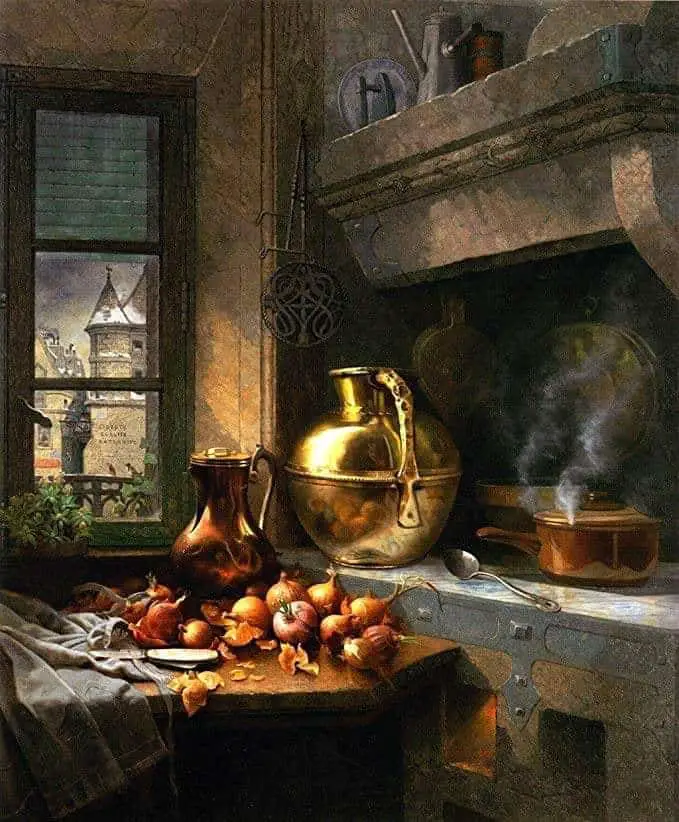Kitchens are wonderfully useful for writers. Of all the rooms in the house, the kitchen offers props for fleshing out body language beats. It offers implements that might kill you, as well as food that might sustain you. People naturally gather in kitchens, even people who despise each other.
For a wonderful visual example of how a benign kitchen can be something truly sinister, see the opening credits to TV show Dexter, in which a sociopathic murderer gets up, shaves, cuts himself, then makes himself breakfast. However, the slo-mo and the close ups turn this into a sequence I can barely watch.
Not surprisingly, I find far more examples of kitchens in work by women. Some writers really enjoy the kitchen as a setting — Alice Munro is one such writer.
KITCHEN NUMBER ONE: “QUEENIE” BY ALICE MUNRO
I looked at the rusty-bottomed bread tin swiped too often by the dishcloth, and the pots sitting on the stove, washed but not put away, and the motto supplied by Fairholme Dairy: The Lord is the Heart of Our House. All these things stupidly waiting for the day to begin and not knowing that it had been hollowed out by catastrophe.
This contrasts with Queenie’s new kitchen, after she elopes:
The kitchen was the nicest room, though too dark. Queenie had ivy growing up around the window over the sink, and she had wooden spoons sticking up out of a pretty, handleless mug, just the way Mrs Vorguilla used to have them. The living-room had the piano in it, the same piano that had been in the other living-room. There was one armchair and a bookshelf made with bricks and planks and a record-player and a lot of records sitting on the floor. No television. No walnut rocking-chairs or tapestry curtains. Not even the floor-lamp with the Japanese scenes on its parchment shade. Yet all these things had been moved to Toronto, on a snowy day.
Alice Munro, “Queenie“
KITCHEN NUMBER TWO: “FICTION” BY ALICE MUNRO
In the following scene, the reader is reminded that Joyce now feels old. The devilled eggs symbolise this change: once popular party foods of the 80s, by the late 90s, nobody was eating eggs anymore.
They are washing the dishes in the kitchen. Joyce and Tommy and the new friend, Jay. The party is over. People have departed with hugs and kisses and hearty cries, some bearing platters of food that Joyce has no room for in the refrigerator. Wilted salads and cream tarts and devilled eggs have been thrown out. Few of the devilled eggs were eaten anyway. Old-fashioned. Too much cholesterol.
“Too bad, they were a lot of work. They probably reminded people of church suppers,” says Joyce, tipping a platterful into the garbage.
“My granma used to make them,” says Jay. These are the first words he has addressed to Joyce, and she sees Tommy looking grateful. She feels grateful herself, even if she has been put in the category of his grandmother.
“We ate several and they were good,” says Tommy. He and Jay have worked for at least half an hour alongside her, gathering glasses and plates and cutlery that were scattered all over the lawn and verandah and throughout the house, even in the most curious places such as flowerpots and under sofa cushions. The boys—she thinks of them as boys—have stacked the dishwasher more skillfully than she in her worn-out state could ever manage, and prepared the hot soapy water and cool rinse water in the sinks for the glasses.
“We could just save them for the next load in the dishwasher,” Joyce has said, but Tommy has said no.
“You wouldn’t think of putting them in the dishwater if you weren’t out of your right mind with all you had to do today.” Jay washes and Joyce dries and Tommy puts away. He still remembers where everything goes in this house.
“Fiction” by Alice Munro
KITCHEN NUMBER FOUR: “JAKARTA” BY ALICE MUNRO
Sonje’s kitchen is described via the viewpoint of an older male visitor, so Munro is channeling a male when she points out what he would notice:
The kitchen was another big room, which the cupboards and appliances didn’t properly fill. The floor was gray and black tiles — or perhaps black and white tiles, the white made gray by dirty scrub water. […] As they passed through the kitchen Sonje had put the kettle on for tea. Now she sat down in one of the chairs as if she too was glad to settle. […] The telephone was rining. A disturbing, loud, old-fashioned ring. It sounded as if it was just outside in the hall, but Sonje hurried back to the kitchen.
“Jakarta” by Alice Munro
KITCHEN NUMBER FOUR: “PINE” BY ROBIN BLACK
This description opens the short story. The kitchen is used to introduce us to the first person narrator (our viewpoint character) and to Heidi, the focal character. This is an example of a character sketch—really two character sketches—using choices about kitchen design as a point of difference between them. So, a different kind of conflict:
Heidi’s kitchen floor is marble tile, a hard and unforgiving platform for her clumsy gait. If it were me, I think, watching her, I would have put down pine—soft, uneven planks of gentle pine to absorb the step-clump, step-clump sound of my own feet. My foot, and then the pause that would be seared into my soul, that sad and silent pause. And then my other foot.
If it were me, I would have built a smaller kitchen too, I’m sure, a room of easy reaches and rolling carts. But Heidi, with her latest-model leg—her fourth she told me, since losing the original—Heidi is more defiant than I, perhaps. More feisty. Or possibly just more in denial. And so her kitchen is bowling-alley large. Stadium large. Super-dome large. There are two cooktops, two dishwashers, two ovens, and a microwave. There are appliances so modern that their function is indiscernible, and these marvels are spread across three islands all in all, an archipelago of kitchen design, which Heidi navigates with great goodwill, cheerful as she clumps across each expanse.
KITCHEN NUMBER FIVE: A COUNTRY WHERE YOU ONCE LIVED BY ROBIN BLACK
The father in this short story is seeing his estranged daughter for the first time in four years. He focuses on the knife in her hands, which makes him feel uncomfortable. Or is it really the knife that’s making him uncomfortable?
“We’re not there yet.” Zoe is peeling a potato — with a knife — so rapidly Jeremy is fearful for her hands. “But we’ll get there. We do have bills to pay, and designer veggies are like gold.”
“I’m looking forward to hearing all about it,” Jeremy says. His gaze is fixed on the course of her blade, on the flying strips of skin. “I’m looking forward to seeing it all.”
“I’ll give you a tour,” Colin says. “The whole operation.”
“Not today, though.” Zoe’s potato falls into a ceramic bowl: another takes its place in her hands. “Dinner’s in just a little while. I hope everyone’s hungry.”
“A Country Where You Once Lived” by Robin Black
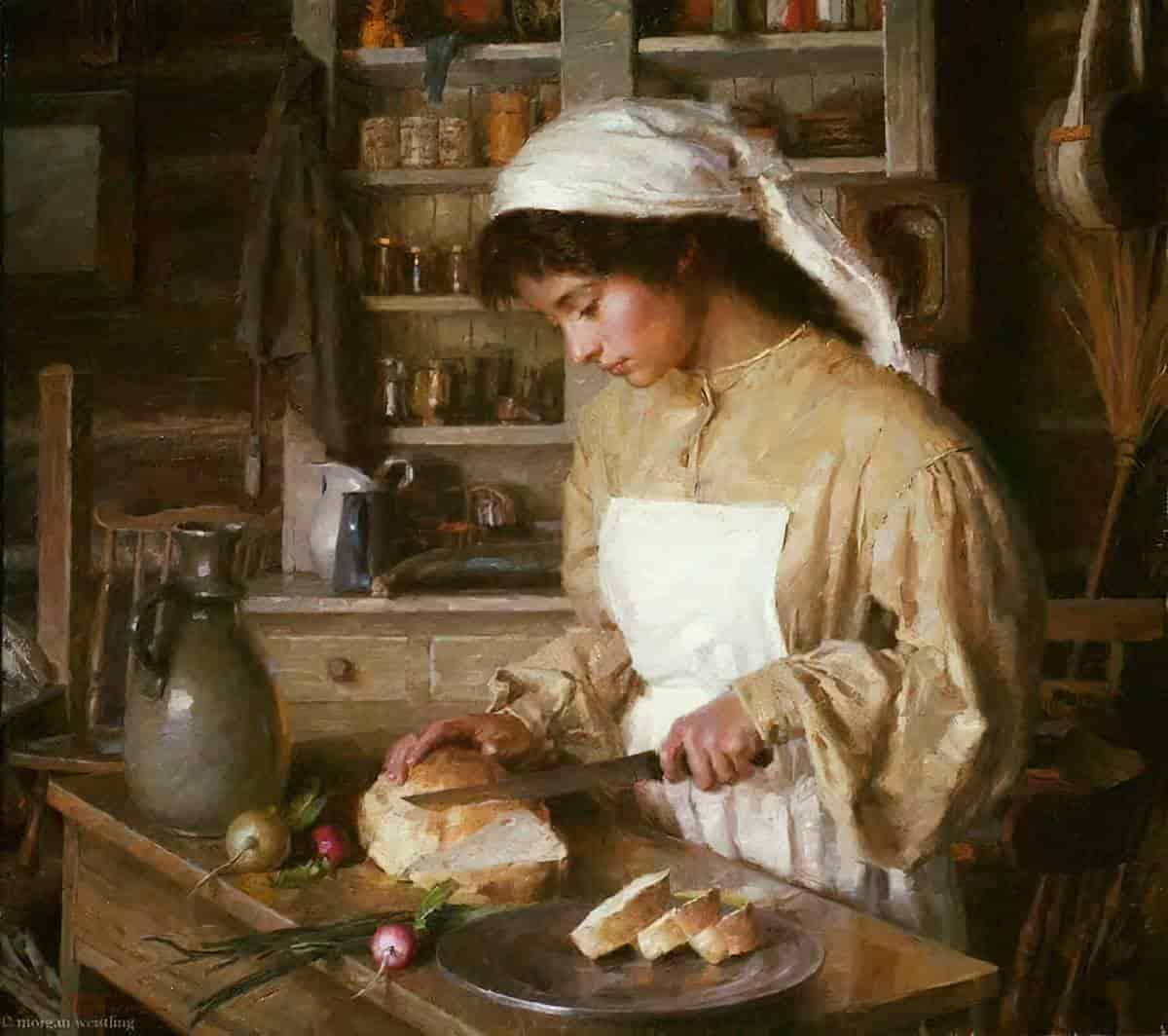
KITCHEN NUMBER SIX: WIFEY REDUX BY KEVIN BARRY
In this short story, Kevin Barry’s main character — a middle-aged dad of a teenage daughter — is coming to terms with the fact he is no longer young himself. His own teenager is an unwelcome reminder of lost youth. Although he has everything he could possibly want — a nice middle class house, the works — now all he wants is to be young again.
Note how Barry paints a portrait of a well-off family — the food they eat, the alcohol of choice, the ‘island counter’ — these details turn the main character’s life into a caricature of middle class success, thereby questioning the very notion of success.
A sunny Saturday, heaven-sent, in peejays — it should have been perfection. Saoirse was sitting at the island counter, trembling, as she ate pinhead porridge with acai fruit and counted off the hours till she could start glugging back the ice-cold Pinot Grigio. I was scraping an anti-death spread the colour of Van Gogh’s sunflowers onto a piece of nine-grain artisanal toast. Ellie was vexing between flushes of crimson rage and sobbing fits and making a sound like a lung-diseased porpoise.
“Wifey Redux” by Kevin Barry
KITCHEN NUMBER SEVEN: ITHACA IN MY MIND BY PETER TEMPLE
The main character in this short story is a self-important writer, annoyed after being fired by his literary agent. We see him take his annoyance out on everyone and everything. Here, it’s the toaster (I think it’s a dig at the Thermomix and similar kitchenware). I like this example because there can be conflict in the kitchen even when a character stands alone in it:
He made toast in the machine she had bought: five hundred and forty dollars. The bloody thing had twelve settings. Numbers one to six barely warmed the bread, seven and upwards charred it just as effectively as some twenty-five dollar piece of shit from Target.
“Ithaca In My Mind” by Peter Temple
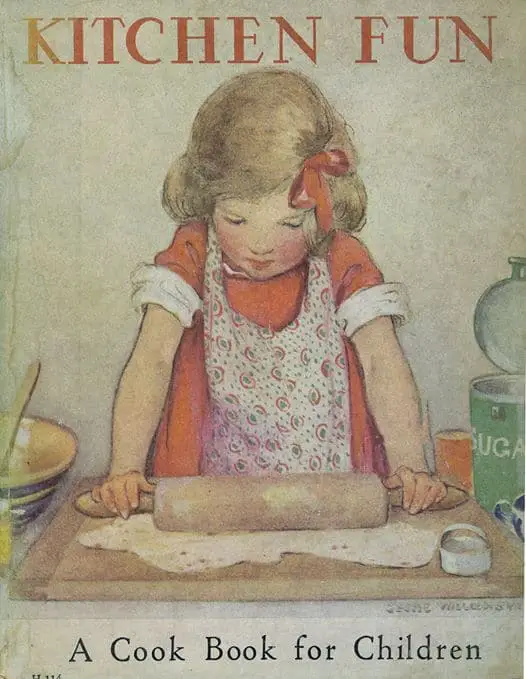
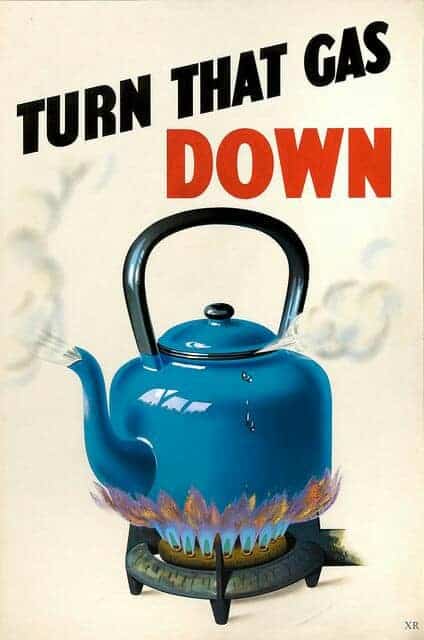
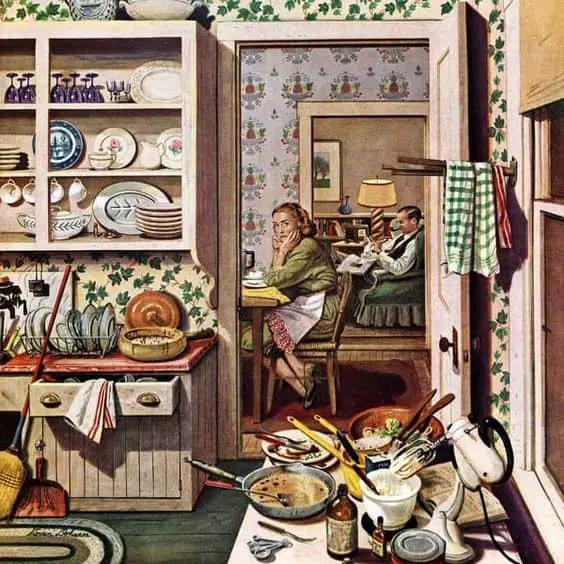
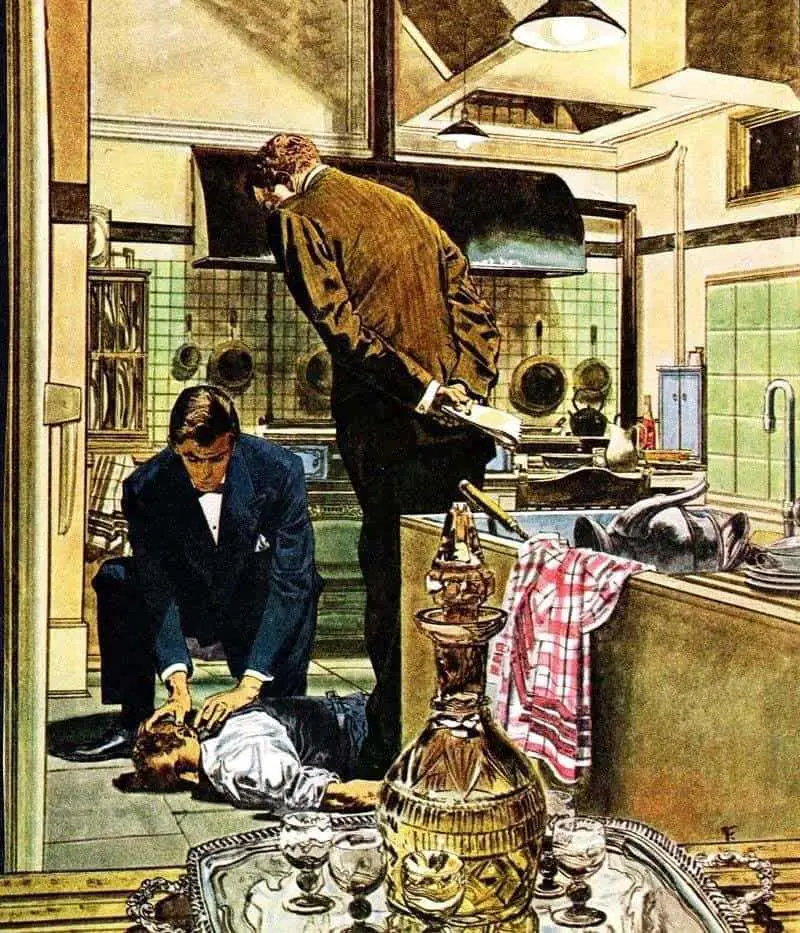

FURTHER READING
Painting in header: Edwin Deakin (British-American, 1838 – 1923) Kitchen Corner, 1883
